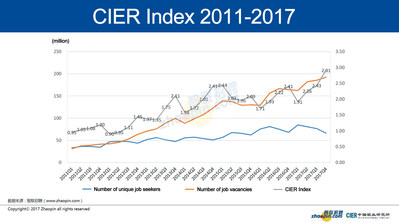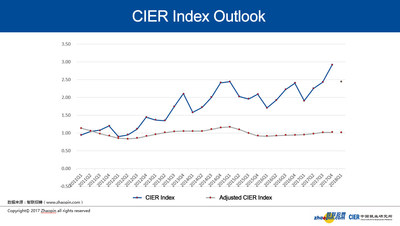China Labor Market Index Hits Record High in the Fourth Quarter of 2017
BEIJING, Jan. 18, 2018 /PRNewswire/ -- Zhaopin Limited ("Zhaopin" or the "Company"), a leading career platform in China focused on connecting users with relevant job opportunities through their career lifecycle, and the China Institute for Employment Research ("CIER") at Renmin University of China released the CIER Employment Index Report for the fourth quarter of 2017.
As the overall economy continued to grow steadily in China, the demand for labor kept increasing in the fourth quarter of 2017. However, the labor supply declined in the slow season for job seekers, which pushed the CIER index to a record high of 2.91, which means there were 2.91 job vacancies for each unique job seeker in the fourth quarter of 2017.
China's fourth-quarter 2017 labor market highlights:
- With a favorable macro-economic environment, the CIER index for the labor market reached a record high of 2.91 in the fourth quarter of 2017, the highest level since the CIER index was released in first quarter of 2011.
- The new record in the CIER index was caused by increasing labor demand, and a decline in job seekers in the fourth quarter.
- Internet and e-commerce continued to be the best-performing sector, while environmental protection was the worst.
- Eastern China continued to enjoy the highest CIER index score of 2.57, followed by 2.09 for Central China and 1.74 for Western China.
- The CIER index is expected to adjust seasonally in the first quarter of 2018 and keep the upward momentum in the second half of 2018.
Methodology and how to interpret the data
Based on data from Zhaopin's online recruitment platform, the CIER index tracks the ratio changes between job vacancies and job seekers in a variety of industries and cities across the country, and identifies the overall trend in China's employment market. Jointly published by Zhaopin and the CIER at Renmin University of China every quarter, the CIER index has become a leading barometer of China's labor market and macro-economic environment.
The CIER index score is calculated by dividing the number of job vacancies during a specified period by the number of unique job seekers during the same period. A CIER index score of more than 1 indicates that the labor market is booming, with more vacancies than job seekers. A CIER index score of less than 1 indicates that the labor market competition is intensifying, with more job seekers than available vacancies.
CIER index hitting record high
In the fourth quarter of 2017, the economy in China continued to grow steadily. Experts expected the GDP to increase by 6.7% year-over-year in the fourth quarter. With the favorable macro-economic environment, the CIER index for the labor market reached a record high of 2.91 in the fourth quarter of 2017, the highest level since the CIER index was released in the first quarter of 2011. The index was much higher than 2.43 in the third quarter and 2.26 in the second quarter.
The new record in the CIER index was caused by increasing labor demand, and a decline in job seekers in the fourth quarter. The steady economic growth created more job demand in the country. According to Zhaopin's data, total online recruitment demand in China rose 39% year-over-year in the fourth quarter of 2017. Meanwhile, the number of job seekers declined in the fourth quarter over the previous quarter, as it was the traditional slow season for job hopping.
CIER index by sectors
The gap between best-performing sector and worst-performing sector narrowed in the fourth quarter of 2017. The CIER index of the best performing sector was 14 times better than that of the worst performing sector, compared with 28 times gap in the third quarter.
The internet/e-commerce sector continued to be the best-performing sector in the fourth quarter of 2017 with a CIER index of 10.24. Traffic/transportation, insurance and intermediary service also performed well in the fourth quarter.
| Ten best-performing sectors in the fourth quarter of 2017 |
||
| Ranking |
Sector |
CIER index |
| 1 |
Internet/e-commerce |
10.24 |
| 2 |
Traffic/transportation |
6.93 |
| 3 |
Insurance |
6.13 |
| 4 |
Intermediary service |
6.08 |
| 5 |
Education/training/college |
5.7 |
| 6 |
Electronics/semiconductor/integrated circuit |
5.33 |
| 7 |
Real estate/construction/building materials/engineering |
5.02 |
| 8 |
Media/publishing/movie and TV/culture communications |
4.6 |
| 9 |
Professional service/consulting (finance and accounting, legal |
4.07 |
| 10 |
Funds/securities/futures/investment |
3.92 |
Most of the worst-performing sectors were traditional manufacturing industries suffering from over-capacity, including printing/packaging/papermaking, electricity/power/water conservancy, and instruments/apparatuses/industrial automation. But the CIER index for these sectors went up slightly in the fourth quarter of 2017 over the third quarter.
| Ten worst-performing sectors in the fourth quarter of 2017 |
||
| Ranking |
Sector |
CIER index |
| 1 |
Environmental protection |
0.73 |
| 2 |
Printing/packaging/papermaking |
0.76 |
| 3 |
Electricity/power/water conservancy |
1.02 |
| 4 |
Instruments/apparatuses/industrial automation |
1.02 |
| 5 |
Office supplies and equipment |
1.03 |
| 6 |
Inspection/testing/authentication |
1.13 |
| 7 |
Petroleum/petrochemical/chemical |
1.15 |
| 8 |
Leasing service |
1.17 |
| 9 |
Property management/business center |
1.2 |
| 10 |
Gifts/toys/arts and crafts/collection/luxuries |
1.23 |
The financial sector continued to suffer with a 23% drop in job demand in the fourth quarter of 2017 year-over-year, and the demand in first-tier cities tumbled by 53% in the quarter. The only growth in job demand came from third-tier cities in the fourth quarter. The tightening supervision by the government led to slowdown in both traditional finance industry and internet finance sector.
| Year-over-year change in recruitment demand for |
|
| Nationwide |
-23% |
| First-tier cities |
-53% |
| Emerging first-tier cities |
-2% |
| Second-tier cities |
-10% |
| Third-tier cities |
90% |
The real estate sector witnessed job demand surging 53% year-over-year in the fourth quarter of 2017. The demand was primarily coming from third-tier and fourth-tier cities, while the demand declined in first-tier cities with imposed restrictions to curb bubbles.
| Year-over-year change in recruitment demand for real estate |
|
| Nationwide |
53% |
| First-tier cities |
-7% |
| Emerging first-tier cities |
34% |
| Second-tier cities |
43% |
| Third-tier cities |
203% |
| Fourth-tier cities |
640% |
The IT and internet sector slowed down its growth in the fourth quarter of 2017 with job demand increasing 30% year-over-year. The industry also saw job demand move from big cities to smaller cities, which were more competitive in costs.
| Year-over-year change in recruitment demand for |
|
| Nationwide |
30% |
| First-tier cities |
-2% |
| Emerging first-tier cities |
46% |
| Second-tier cities |
12% |
| Third-tier cities |
86% |
| Fourth-tier cities |
324% |
The retail/wholesale sector enjoyed fast growth in the year-end shopping season. Job demand in the sector jumped 88% in the fourth quarter of 2017 year-over-year. The demand for jobs was especially strong in third-tier and fourth-tier cities as consumption had been spreading to small cities in China.
| Year-over-year change in recruitment demand for |
|
| Nationwide |
88% |
| First-tier cities |
46% |
| Emerging first-tier cities |
125% |
| Second-tier cities |
39% |
| Third-tier cities |
137% |
| Fourth-tier cities |
395% |
CIER index by regions and cities[1]
In the fourth quarter of 2017, Eastern China continued to enjoy the highest CIER index score of 2.57, followed by 2.09 for Central China and 1.74 for Western China. However, Northeast China saw its CIER index decline to 1.20 from 1.42 in the third quarter. The job demand in Northeast China dropped by 9.6% in the fourth quarter over the previous quarter, while job seekers increased by 3.4% quarter-over-quarter.
| CIER index by regions |
|||
| Region |
4Q 2017 CIER |
4Q 2016 CIER |
3Q 2017 CIER |
| Eastern China |
2.57 |
2.07 |
2.14 |
| Central China |
2.09 |
1.94 |
1.92 |
| Western China |
1.74 |
1.77 |
1.63 |
| Northeast China |
1.20 |
1.40 |
1.42 |
Compared with the third quarter, the CIER index increased for cities of all tiers in the fourth quarter of 2017. The CIER index for first-tier cities was 0.85 in the fourth quarter, indicating more job seekers than available job vacancies in these cities. The job demand in first-tier cities actually dropped by 6% year-over-year in the fourth quarter.
| CIER index by cities |
|||
| City |
4Q 2017 CIER |
4Q 2016 CIER |
3Q 2017 CIER |
| First-tier cities |
0.85 |
0.93 |
0.68 |
| Emerging first-tier cities |
1.44 |
1.48 |
1.31 |
| Second-tier cities |
2.53 |
2.23 |
2.15 |
| Third-tier cities |
3.18 |
2.46 |
2.92 |
CIER index by size of companies
In the fourth quarter of 2017, large-sized companies had the highest CIER index of 2.61, up from 1.90 in the third quarter. Meanwhile, CIER index for micro-sized companies fell significantly from 2.27 in the third quarter to 1.96 in the fourth quarter.
| CIER index by size of companies |
||
| Company size |
4Q 2017 CIER |
3Q 2017 CIER |
| Large-sized (more than 10,000 employees) |
2.61 |
1.90 |
| Medium-sized (500 to 9,999 employees) |
1.39 |
1.01 |
| Small-sized (20 to 499 employees) |
1.34 |
1.42 |
| Micro-sized (fewer than 20 employees) |
1.96 |
2.27 |
CIER index by type of companies
Private companies continued to enjoy the highest CIER index of 1.63 in the fourth quarter of 2017, followed by 1.50 for public companies. Wholly foreign-owned enterprises had the lowest CIER of 0.93 in the fourth quarter with more job seekers than job vacancies, but the index improved from 0.59 in the third quarter.
| CIER index by type of companies |
||
| Company size |
4Q 2017 CIER |
3Q 2017 CIER |
| Private companies |
1.63 |
1.68 |
| Shareholding companies |
1.47 |
1.50 |
| State-owned enterprises |
1.30 |
1.25 |
| Joint ventures |
1.43 |
1.35 |
| Wholly foreign-owned enterprises |
0.93 |
0.59 |
| Public companies |
1.50 |
0.65 |
Labor market outlook
The CIER index is expected to adjust seasonally in the first quarter of 2018 and keep the upward momentum in the second half of 2018.
For more information, please contact:
Zhaopin Limited
Ms. Daisy Wang
Investor Relations
[email protected]
ICR Beijing
Mr. Edmond Lococo
Phone: +86 10 6583-7510
[email protected]
| [1] Cities are categorized to tiers based on standard of CBN Weekly. First-tier cities include Beijing, Shanghai, Guangzhou and Shenzhen. Emerging first-tier cities include Chengdu, Dalian, Dongguan, Hangzhou, Nanjing, Ningbo, Qingdao, Shenyang, Suzhou, Tianjin, Wuhan, Xi'an, Changsha, Zhengzhou, and Chongqing. Second-tier cities include Changzhou, Foshan, Fuzhou, Guiyang, Harbin, Hefei, Huizhou, Jinan, Jiaxing, Kunming, Nanchang, Nanning, Nantong, Quanzhou, Shijiazhuang, Taiyuan, Weifang, Wenzhou, Wuxi, Xuzhou, Yantai, Yangzhou, Changchun, Zhongshan, Zhuhai. Third-tier cities include Baotou, Daqing, Hohhot, Huai'an, Linyi, Luoyang, Qinhuangdao, Weihai, Xianyang and Zhenjiang. |
SOURCE Zhaopin Limited
WANT YOUR COMPANY'S NEWS FEATURED ON PRNEWSWIRE.COM?
Newsrooms &
Influencers
Digital Media
Outlets
Journalists
Opted In


Share this article